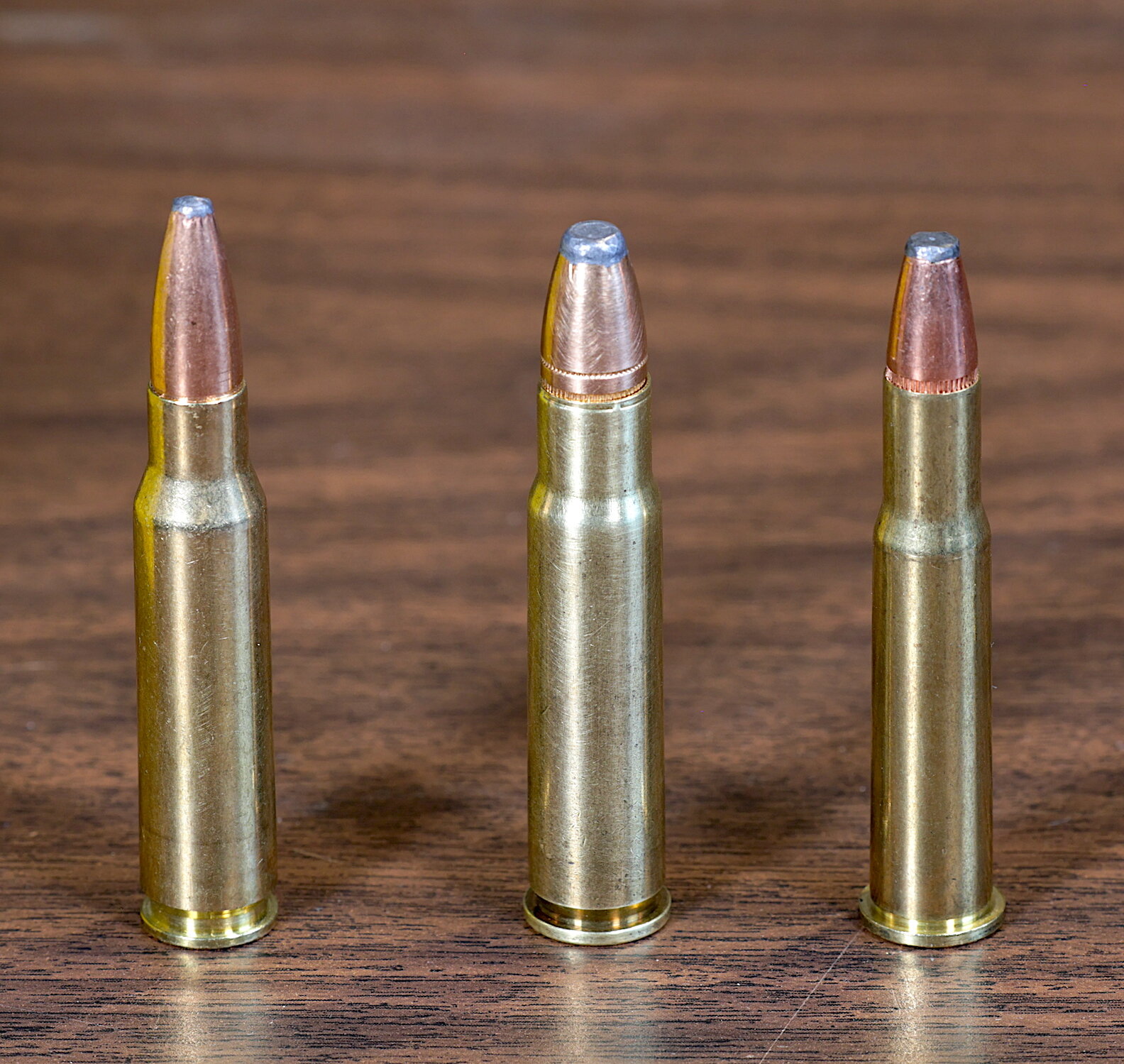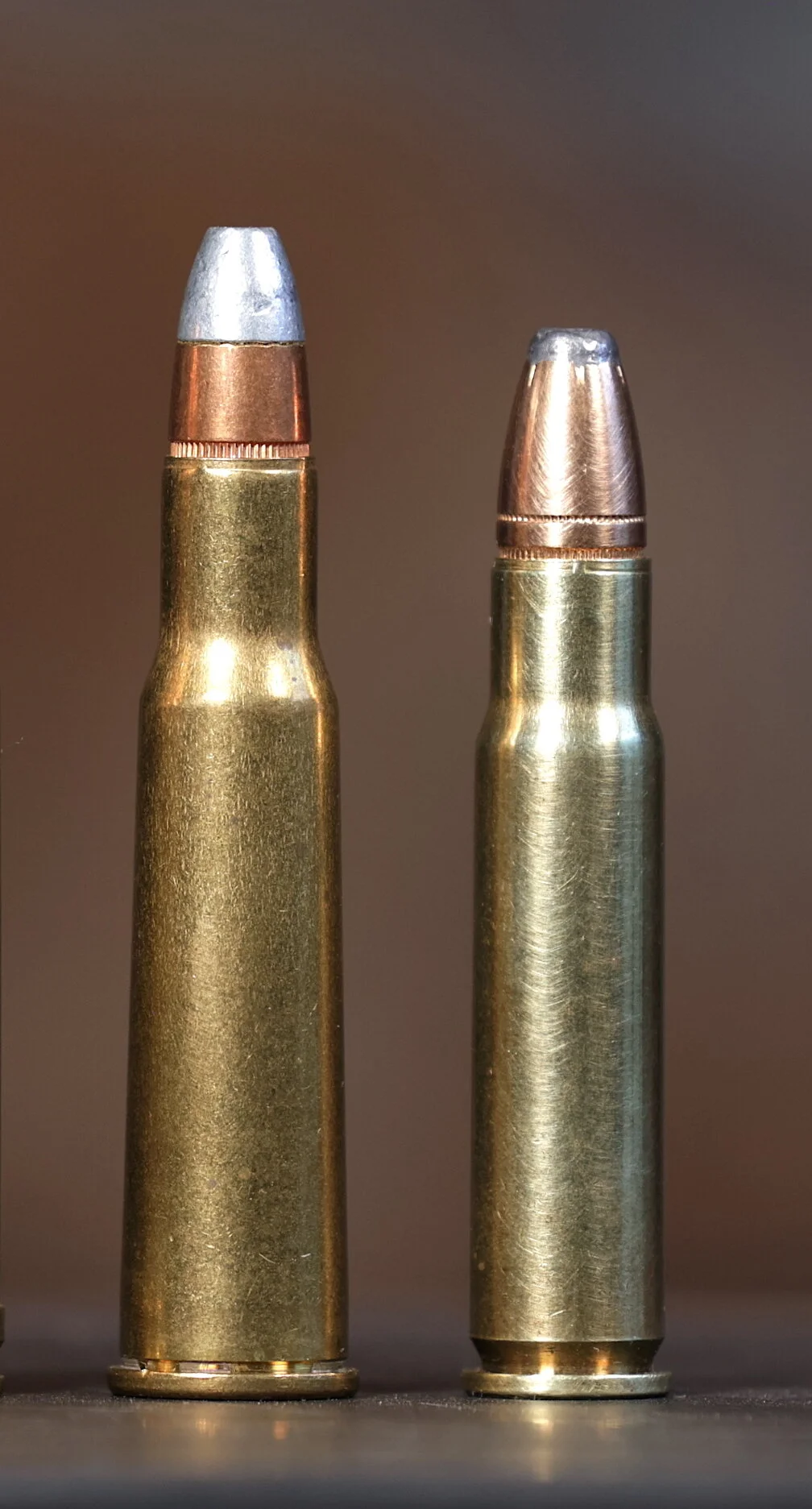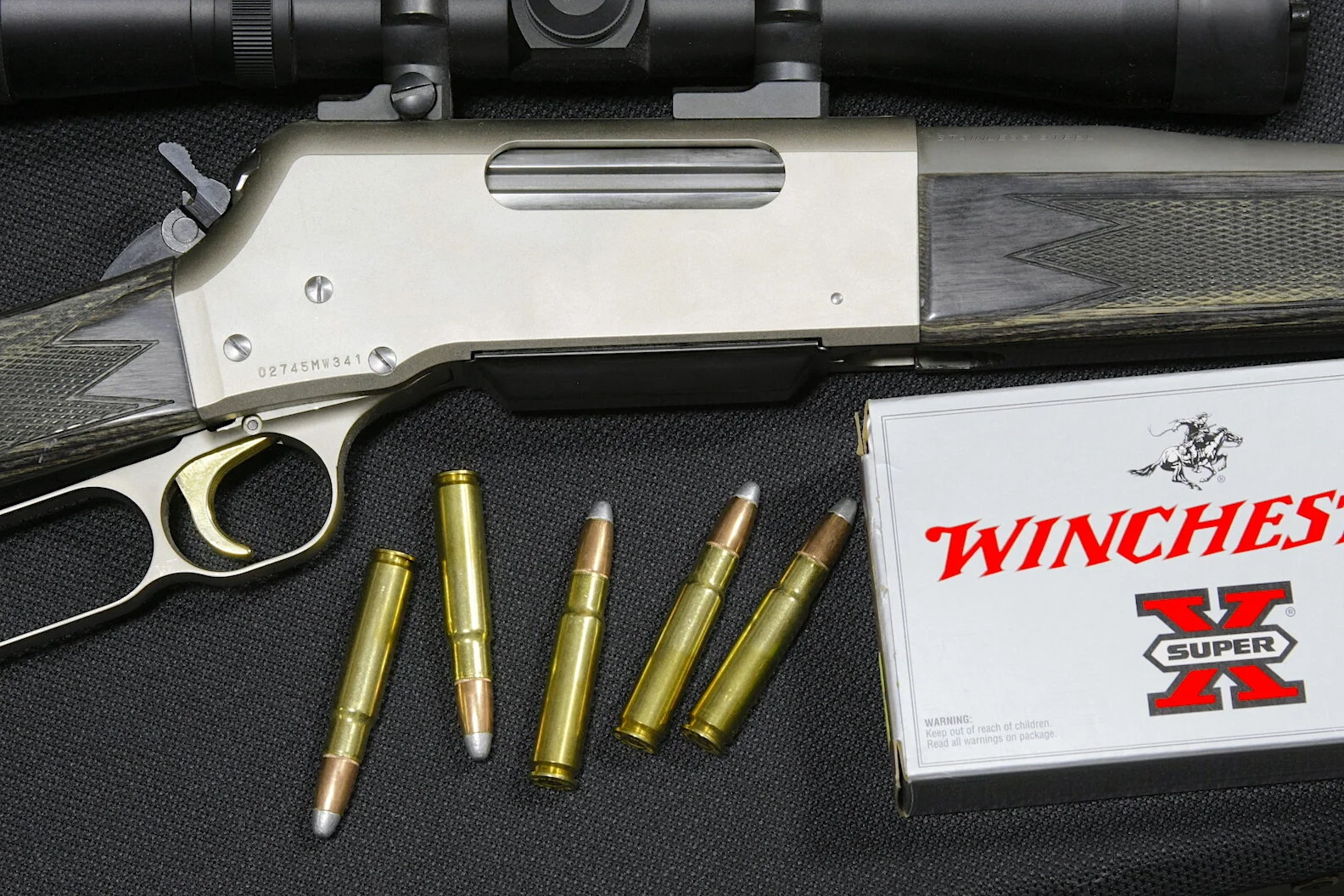The 358 Winchester/356 Winchester Confusion
by Ron Spomer
Numbers don’t lie. But they aren’t always accurate, either.
The number 356 in front of the brand name Winchester denotes the official name of a little-known, 35-caliber rifle cartridge that is really a .358, but not THE 358.
Confusing, isn’t it?
The 356 Winchester (center) takes the body of the 308 Win. (left) and the rim of the 30-30 (right) to make a lever-action version of the 358 Winchester (not shown.)
Tracking Down the 356 Winchester
Let’s see if we can clear the air and come to an understanding as to just what the heck a 356 Winchester is. It’s a long, winding ride that’ll take us past famous lever actions and bolt actions and long actions and short actions and even glance at the 338 Winchester Magnum. Hang on…
The year is 1952. War is raging in Korea. Truman is in the Whitehouse, but in November Eisenhower wins in a landslide over Adlai Stevenson. The first commercial airline flight crosses over the North Pole takes passengers from Los Angeles to Copenhagen. Wernher von Braun predicts humans will soon travel to the moon. Meanwhile, Earthbound, Winchester takes to market a shortened version of the 30-06 they christened the 308 Winchester. It had emerged from the military’s T65 program aimed at finding a smaller replacement for the 30-06. The ink had barely dried on the 308 ad campaign when, in 1955, Winchester stretched their new 308’s neck to fit a .358” bullet. They called it, easily enough, the 358 Winchester. So far so good.
This new, short-action cartridge wasn’t necessarily created to replace the aging, rimmed 348 Winchester, then still available in the Model 71 lever action rifle (the only rifle ever sold in 348 Winchester,) but ballistically it did. Not surprisingly, the brand new, fully modern, hammerless, Model 88 lever action rifle with vertical-stack magazine was also unveiled in 1955. The very next year it was chambered for the 358 Winchester.
While the 348 Win. shoved a 250-grain bullet 2,350 fps, the 358 Win. could drive the same weight slug 2,400 fps. A lighter recoiling 200-grain from each would hit about 2,500 and 2,700 fps respectively. But this is just the beginning of the ballistic story.
The 348 Win. is larger than the 356 Win. (rimmed version of 358 Win.) This 356 isn’t wearing the sharply pointed, long ogive, high B.C. bullets the 358 Win. could handle.
Ballistically Better
Because the 348 rode in a tubular magazine rifle, it had to wear flat-nosed or at best round-nosed bullets low on B.C. The 358 Win. fired sharply tipped bullets carried in vertically stacked magazines. Well, you know what that meant downrange — the more aerodynamically efficient .358 bullets carried the mail. The 348 started considering early retirement. With both zeroed 2 inches high at 100 yards, the 348 Win. drops and drifts a couple of inches more at 225 yards. No big deal. But its 438 foot-pounds energy deficit bothers some. That’s a lot of horsepower to give up in a cartridge celebrated for its elk stopping horsepower.
348 Winchester, 200-grain Hornady InterLock FP
358 Winchester, 200-grain Hornady InterLock SP
So, the 358 Winchester is ballistically superior to the 348 Winchester. The latter was discontinued in 1958. Alas, that did not power the 358 Win. to record sales. And you can’t blame the Model 88 lever-action rifle in which it was chambered because Winchester also chambered it in its venerable Model 70 bolt-action. Nevertheless, hunters avoided the 358 Winchester in droves.
This does not mean the cartridge was or is a dog. Nor that it was useless, superfluous, or ridiculous. Ballistically it was and remains an excellent mid-range hunting round for anything in North America and most of Africa, at its best with 220-grain bullets driven about 2,500 fps, just 100 fps behind the 35 Whelen. Zero it 2 inches high at 100 yards and it doesn’t drop 4 inches below point-of-aim until about 230 yards. At 250 yards it is still packing more than 1,500 f-p energy. Elk medicine in a quick, short-action rifle with about the same kick in an 8-pound rifle as a 30-06. Put another way, the 358 Winchester generates 13 f-p less recoil energy than the 338 Win. Mag. (released in 1958) throwing a 225-grain bullet.
358 Winchester, 220-grain Speer SPFN Hot-Core
Birth of the 356 Winchester
Christen the 358 Winchester, then, as hard-hitting and efficient. But ho hum boring. At least that’s what sales indicate.
Now to the obscure, if not enigmatic, 356 Winchester. If you knew little to nothing about the 358 Winchester, chances are you’ll know less about the 356 Winchester, which is essentially the 358 with a rim.
Fast forward to 1982. With the 348 dead and the 358 moribund, Winchester decided to tempt fate again with the 356 Winchester. Not only would it nearly match those other two, but it would handily beat the old 35 Remington, still a venerated lever-action brush round and competitor to Winchester’s own 30-30. Would a fresh crowd fall for this one?
356 Winchester, 220-gr. Speer SPFN
No. Despite Big Red’s best efforts. Here’s how it went down: Hoping to breathe new life into its Model 94 lever actions, Winchester altered the ejection pattern to throw cartridges out at an angle rather than straight up, as all previous Winchester lever actions had done. This would make scope mounting and use easier. At the same time they decided to sprinkle a bit of hot sauce on the old cowboy gun, chambering it for two new, high-energy, high pressure rimmed cartridges, both based on the 308 Winchester. One was the 307 (a rimmed 308,) the other the 356, a rimmed 358 with a slightly shorter body and overall length.
To accommodate the higher pressures in these rounds, the M94 XTR Angle-Eject actions were beefed up (thickened) at the vertically sliding rear locking bar. Alas, the tubular magazine remained, saddling the hot new rounds with ballistically inferior bullets, although that hardly matters at the 200-yard max range usually expected in a brush/woods rifle.
Winchester M94 XTR AE in 356 Winchester. Note the wider action just above the trigger. This is where the vertical locking bar resides.
Death of the 356 Winchester
I remember the release of these two. And I remember considering each as a smart improvement over the old 30-30 and 348, a major advance over the old 35 Remington. But I talked myself out of buying due to those low B.C. bullets. While I wasn’t doting on B.C. back in 1982, I saw the 250-yard and 300-yard data, compared both to my 270 Win., and walked away. I suspect many other hunters at the time came to the same conclusion. If you had a 30-30 for close woods work plus a 270 or 30-06 or 7mm Rem. Mag. or any other modern bottle-necked cartridge in a bolt action, you had a hard time justifying a 356 Winchester. Marlin chambered its 336 in 356 Win. until 1987. Winchester dropped the chambering in the mid-1990s.
35 Remington, 220-grain Speer SPFN
But Why The 356 Number?
This finally brings us back to those 356 numbers. Those confusing, if not lying, numbers. Why name a cartridge that throws a .358” diameter bullet from a 35-caliber bore a 356? Because the 358 Winchester title was already taken! As the 223 Rem., 225 Win., 244 Rem. and many others prove, cartridge names do not have to accurately reflect the dimensions of their bores or the bullets they shoot.
30-30 Winchester, 170-grain Speer SPFN
As the video accompanying this post demonstrates, the M94 Winchester XTR Angle Eject in 356 Winchester could shoot! In addition to punching that sub-MOA group with John’s handloads, I later slapped a 300-yard, 14-inch steel plate with my first shot, holding 2 MOA into the wind and about 6 MOA high (Kentucky windage.) We didn’t include that 300-yard shot in the video because the slo-mo camera on the target failed.
Browning’s excellent, vertical-stack magazine BLR is still chambered in 358 Winchester, likely the only commercial rifle still made in this chambering. While these rather blunt Silvertips are effective for close range work, more aerodynamic offerings from Winchester and Hornady milk more potential from this cartridge. This is the major advantage the 358 has over the 356 — higher B.C. bullet options.
Conclusion
What’s the take-away on the 356/358 Winchesters? If you love lever actions and want more horsepower than the old 30-30, 32 Special, and 35 Remington, the 356 Winchester could be your baby. But check ammo availability. With today’s ammo shortages, 356 Win. cartridges aren’t likely to be produced again anytime soon. Forming other brass to fit is problematic because of the rim. One option might be 444 Marlin brass. Regular 308 Winchester brass can be reformed to make 358 Win. brass.
The easier option of these two fine 35-caliber cartridges would be to get the BLR or find a used 358 Win. bolt action (Ruger was chambering it a few years ago) or rebarrel a 308 Win. You’ll get 100 fps more velocity than the original M94 356 plus the option to shoot those higher B.C. bullets. But you’ll miss the speed and nostalgic fun of the M94 XTR Angle Eject lever-action Winchester.
# # #














